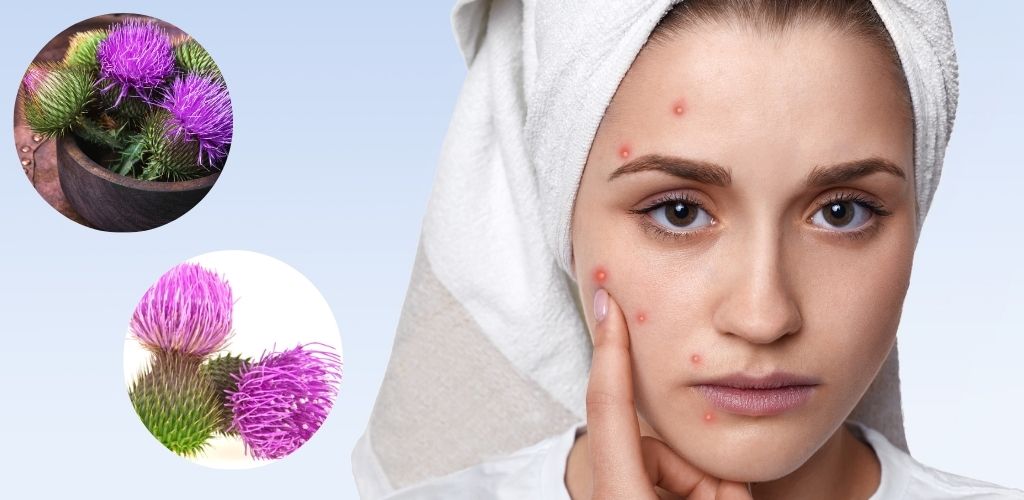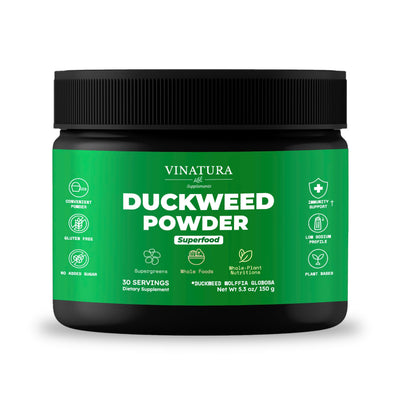
Benefits Of Milk Thistle For Acne & How To Use It For Acne?
Acne is a common skin condition that affects millions of people worldwide. While numerous therapy options are available, one natural remedy that has gained popularity in recent years is milk thistle (MT).
This herb, also known as Silybum marianum, has been used for centuries for its medicinal properties. In this article, we will explore the benefits of milk thistle for acne and how to use it to improve this skin condition effectively.
Before exploring further, please read the disclaimer located at the end of this webpage.
Does Milk Thistle Help With Acne?

The active complex of MT is an extract derived from the plant's seeds. It consists of three flavonolignan isomers, namely silybin, silydianin, and silychristin, collectively known as silymarin.
The antioxidant formulation containing 0.5% silymarin showed promising results in improving acne's clinical severity and positively impacting various skin biophysical parameters [1].
These findings suggest the potential of this formulation as a valuable addition to acne treatment options, providing further support for its effectiveness in addressing the multifaceted nature of this common skin condition.
Benefits Of Milk Thistle For Acne
1. Antioxidants: Milk thistle is rich in silymarin, a powerful antioxidant that can combat free radicals. Free radicals damage skin cells and contribute to inflammation, both factors in acne development. Silymarin may help reduce acne breakouts and promote healing by neutralizing free radicals [4].
2. Anti-inflammatory properties: Silymarin also has anti-inflammatory effects, which can help reduce redness and swelling associated with acne.[2] This may be especially beneficial for inflammatory acne types, such as cystic acne.
3. Liver detoxification: Acne can sometimes be linked to liver health. Milk thistle's liver-protective properties may help improve overall detoxification, potentially leading to clearer skin [5].
4. Blood sugar regulation: Some research suggests that milk thistle may help regulate blood sugar levels. High blood sugar levels have been linked to acne development, so regulating blood sugar could help improve acne [6].
5. Androgen reduction: Milk thistle may have some ability to reduce androgen levels, hormones that play a role in acne development. This could help reduce the severity of acne breakouts [7].
Milk Thistle For Acne Mechanism

Two key factors, oxidative stress, and inflammatory processes, play a significant role in the pathogenesis of acne vulgaris.
- Silymarin, known for its potent antioxidant and anti-inflammatory activities, emerges as a promising mechanism that significantly reduces acne.[2]
- By targeting these underlying mechanisms, silymarin offers a potential solution to combat acne and promote healthier skin.
Milk Thistle Side Effects Acne
Milk thistle is generally considered safe when taken by mouth in appropriate amounts, but like any substance, it can have side effects, some of which may be relevant to people with acne. Here's a breakdown of potential side effects related to acne:
- Allergic reactions: While rare, allergic reactions to milk thistle can manifest as rashes, itching, or swelling. If you experience any of these, stop taking it and consult your doctor.
- Hormonal changes: Potential hormonal effects with milk thistle, though the evidence is limited. This could worsen acne in some individuals with hormonal imbalances.
How To Use Milk Thistle For Acne

Forms Of Milk Thistle
Milk thistle comes in different forms, including capsules, tinctures, powders, and extracts. Capsules are the most commonly available form and may provide a more convenient way to incorporate this herb into your skincare routine.
You also may like: 10 Best Milk Thistle Supplements for Liver Health
Milk Thistle For Acne Dosage
In the study, participants with acne who took a daily supplement of 210 milligrams of silymarin for eight weeks experienced a significant reduction of 53% in acne lesions.
It has been determined that a safe and effective Milk Thistle for acne dosage is approximately 210 milligrams of silymarin per day. For the fastest and most effective results, combining silymarin with other herbal remedies may be beneficial.
Milk Thistle And Dandelion For Acne
Milk thistle and dandelion are often linked to liver health and detoxification, which can indirectly benefit acne-prone skin.
The dandelion extract possesses anti-viral, anti-inflammatory, and anti-oxidative properties that contribute to anti-aging, collagen production, inflammation reduction, and protection against free radicals, aiding in skin detoxification.[8]
In reality, there is limited research on potential interactions between milk thistle and dandelion when combined, but it's crucial to consult a medical professional before combining these herbs due to possible unknown interactions.
Burdock Root And Milk Thistle For Acne

Burdock root and milk thistle are herbal remedies sometimes suggested for various health benefits, including potential support for skin conditions like acne.
Burdock roots possess anti-acne properties and were historically used to create therapeutic dressing material for treating Gram-positive bacterial infections in individuals with acne.[9]
However, similar to dandelion and milk thistle, little to no interaction was recorded when milk thistle and burdock root were combined. It is essential to consult a medical professional before combining these two herbs to avoid potential side effects.
Other Benefits Of Milk Thistle For Skin
Here are some benefits of milk thistle for skin:
- Antioxidant Properties
- Anti-Aging Properties
- Hydration Skin
- Skin Whitening
- Improving Skin Blemishes
- Improving Inflammatory Skin Issues
Conclusion
Milk thistle, containing silymarin, shows potential benefits of Milk Thistle for acne and skin. Its antioxidant and anti-inflammatory properties target oxidative stress and inflammation, potentially reducing breakouts and promoting healthier skin. It's generally safe and available in various forms like functional food, oil, tea, and capsules. It may also provide additional skin benefits such as anti-aging and improved hydration.
However, use responsibly, considering potential side effects and individual health conditions. Consult a healthcare professional before starting any new supplement regimen. Combining milk thistle with herbs like dandelion and burdock root may enhance overall skin health and appearance.
Related Articles:
- 10+ Benefits of Milk Thistle: Side Effects & Other FAQs
- Benefits Of Milk Thistle For Diabetes & How Does It Help With?
- Benefits Of Milk Thistle For Weight Loss & Usage Guide
References
- [1] Sahib, Ahmed Salih. “Effects of Oral Antioxidants on Lesion Counts Associated with Oxidative Stress and Inflammation in Patients with Papulopustular Acne.” Journal of Clinical & Experimental Dermatology Research, vol. 03, no. 05, 2013, https://doi.org/10.4172/2155-9554.1000163.
- [2] Shie Morteza, Maryam, et al. “Efficacy and Safety of Oral Silymarin in Comparison with Oral Doxycycline and Their Combination Therapy in the Treatment of Acne Vulgaris.” Dermatologic Therapy, vol. 32, no. 6, 21 Oct. 2019, https://doi.org/10.1111/dth.13095. Accessed 28 Sept. 2020.
- [3] Kim, Jemin, et al. “Efficacy and Safety of Silymarin Containing Antioxidant Serum as an Adjuvant Treatment of Mild‐To‐Moderate Acne Vulgaris: A Prospective, Open‐Label Pilot Study.” Journal of Cosmetic Dermatology, vol. 22, no. 2, 31 Oct. 2022, pp. 561–568, https://doi.org/10.1111/jocd.15439. Accessed 21 Jan. 2024.
- [4] Katiyar, S. K. (2005). Silymarin and skin cancer prevention: Anti-inflammatory, antioxidant and immunomodulatory effects (Review). International Journal of Oncology. https://doi.org/10.3892/ijo.26.1.169
- [5] Vargas-Mendoza, N., Madrigal-Santillán, E., Ángel Morales-González, Esquivel-Soto, J., César Esquivel-Chirino, M González-Rubio, Gayosso-de-Lucio, J. A., & Morales-González, J. A. (2014). Hepatoprotective effect of silymarin. World Journal of Hepatology, 6(3), 144–144. https://doi.org/10.4254/wjh.v6.i3.144
- [6] Vahabzadeh, M., Amiri, N., & Karimi, G. (2018). Effects of silymarin on metabolic syndrome: a review. Journal of the Science of Food and Agriculture, 98(13), 4816–4823. https://doi.org/10.1002/jsfa.9115
- [7] Zhu, W., Zhang, J., & Charles Y.F. Young. (2001). Silymarin inhibits function of the androgen receptor by reducing nuclear localization of the receptor in the human prostate cancer cell line LNCaP. Carcinogenesis, 22(9), 1399–1403. https://doi.org/10.1093/carcin/22.9.1399
- [8] Law, Siukan, et al. “Traditional Chinese Herbal, “Dandelion” and Its Applications on Skin-Care.” Traditional and Integrative Medicine, 28 July 2021, https://doi.org/10.18502/tim.v6i2.6794. Accessed 24 Oct. 2021.
- [9] Miazga-Karska, Malgorzata, et al. “Anti-Acne Action of Peptides Isolated from Burdock Root-Preliminary Studies and Pilot Testing.” Molecules (Basel, Switzerland), vol. 25, no. 9, 27 Apr. 2020, pubmed.ncbi.nlm.nih.gov/32349230/, https://doi.org/10.3390/molecules25092027.
Author

Product Disclaimer
Including an ingredient or study does not evaluate, endorse, or recommend any Vinatura product or any third-party product. Some ingredients discussed may not be used in any Vinatura product.
The content of the articles has not been evaluated by the Food and Drug Administration (FDA) and is not intended to promote or endorse any specific product. Any products sold on this website are not intended to diagnose, treat, cure, or prevent any disease.
Opinions and Endorsements
Any claims, statements, or opinions expressed in the articles are those of the author(s) and do not necessarily reflect the views or opinions of the manufacturers of the dietary supplement products. The products sold on this website are separate from the content of the articles and are not directly endorsed or associated with the information presented here.
Liability Disclaimer
The author(s) of the articles, website, and manufacturers of the dietary supplement products do not assume any liability for any potential consequences arising from the use of the information provided in the articles. Ingredient effects, dosages, and safety vary by individual, formulation, and context; some ingredients interact with medications or may be unsuitable during pregnancy or lactation. It is recommended that individuals consult with a qualified healthcare professional before making any dietary or lifestyle changes, including the use of dietary supplements.
Product Usage
Please refer to the product labels and packaging for specific usage instructions and guidelines for the dietary supplement products sold on this website.
Customer Support
For any concerns or questions regarding the dietary supplement products, please contact our customer support team, who will be more than happy to assist you.





Leave a Comment
Be the first to comment.
What do you think?